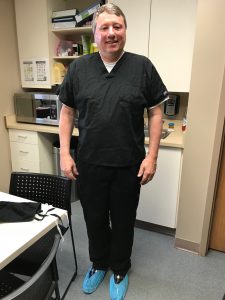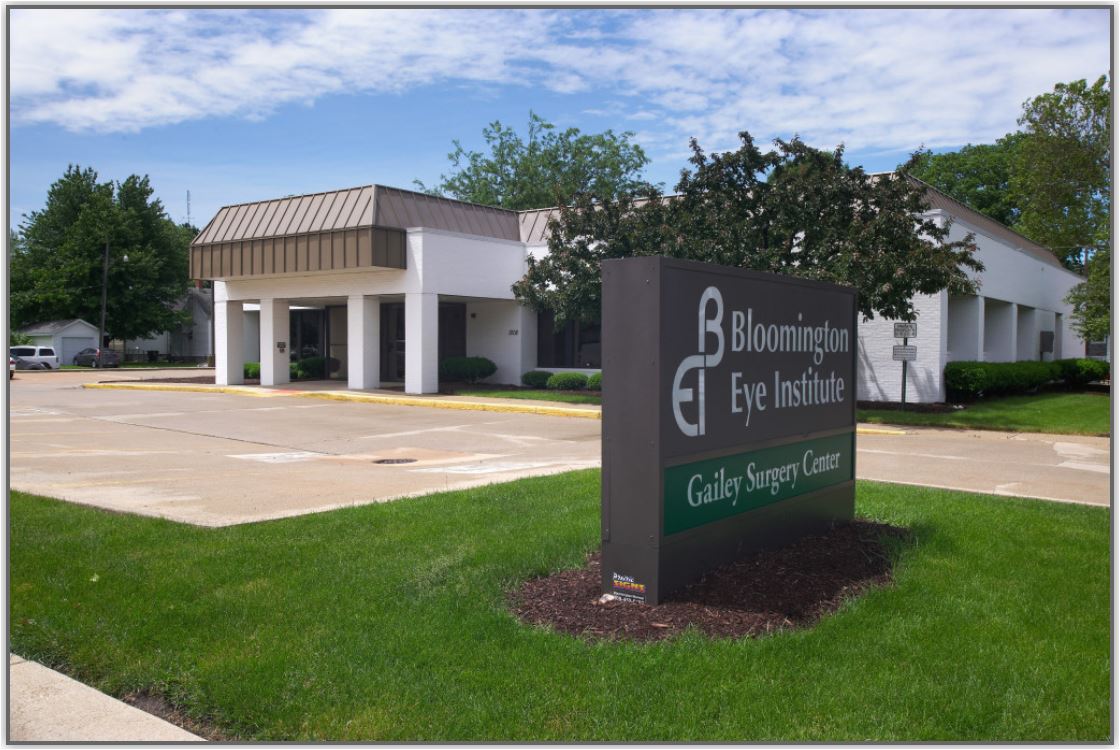To celebrate MCN Nurses’ Week 2018, Illinois State University’s Vice President of Finance and Planning Dan Stephens spent the morning shadowing Karen Magers, a Mennonite College of Nursing grad and director of Ambulatory Surgery Centers for Gailey Eye Clinic.
When Stephens arrives at Bloomington Eye Institute at 8:30 a.m., he trades his suit and tie for scrubs – the same black scrubs that the nursing staff wear, complete with surgical cap – and meets Magers in the staff break room, where a few nurses are briefing one of the surgeons on the next patient.

Dan Stephens in scrubs.
“You can feel the comradery,” Stephens explained. “This isn’t just a team; it’s a family. And beyond that, walking around and watching the efficiency of the staff and surgeons is incredibly impressive. Coming from a background in business and finance, I pay attention to those things,” Stephens said with a laugh. “The surgeons don’t have to ask for anything, everyone just knows their job and works together like a well-oiled machine. It is seamless.”
Magers smiled. “That’s, in part at least, because a lot of us have been here a long time. I started 38 years ago and became director here in 1998, almost 20 years ago.”
It’s also because Magers believes in running a tight ship where people don’t make mistakes. Nurses and staff at Bloomington Eye Institute are committed to the safety and care of their patients.
Magers, a vivacious woman with dark hair, bright eyes and a warm smile, is clearly passionate about what she does. “I started my career at Mennonite Hospital before it merged with BroMenn. I immediately fell in love with eye surgery,” said Magers. “I loved serving as the scrub nurse; everyone involved plays a part, but as the scrub nurse you really are a participant in the surgery. You’re always moving, always ready to hand the surgeon the next instrument. It’s an adrenaline rush,” she explained, leading the way from the break room out into the hallway.
Pausing, Magers gestured to a nurse speaking to a patient in a small room. “This is where we intake patients. The nurse is talking her through what will happen, verifying why she’s here. Which eye, which surgery, which lens.”
“How many people do you see in a day?” Stephens asked.
“Our surgeons generally perform anywhere from 25-35 surgeries per day but have done as many as 50 per day – so, over 4,000 patients per year. Most procedures last between 10 and 15 minutes total. We start doing surgery at 8 a.m., Monday through Thursday,” Magers explained.
Despite the fact that surgeries are outpatient and most are short in duration, you can see worry etched in the eyes of the patients and their loved ones. To them, this isn’t just one surgery in fifty – it’s their eyes. And Magers’ staff understands that.
As Stephens watched, the intake nurse went through her routine, speaking to both the patient and her husband in a confident and comforting way. “Ma’am, can you confirm for me which eye we will be working on today?”
In a low voice, Magers explained, “You’re going to hear that question over and over. We continually verify the details of the surgery as a safety protocol. Even the surgeon, right before the surgery begins.”

Mennonite College of Nursing alum Karen Magers.
From intake, Magers toured Stephens through the bright and sunny pre-op room where patients sit with IVs and wait their turn before heading to surgery.
The Bloomington Eye Institute has two surgery rooms, one of which is equipped with a Femtosecond laser.
“We are very lucky to have it. The laser actually adds about five minutes to the surgery, but it is very precise,” Magers explains.
The Femtosecond laser is used for surgeries that are “more specialized” – meaning, the person may have an astigmatism, or may be getting a specialized lens. The laser performs part of the cataract surgery, including precise incisions and sectioning of the cataract.
“During basic cataracts surgeries, our surgeons make the incisions by hand. Our surgeons here are very skilled, with excellent outcomes.”
As they watch the first surgery, Stephens was again blown away by the efficiency of the team. Nurses and staff prep one surgery room while the surgeon works in the other. Then, the patient is brought in. The surgeon arrives, scrubs in, and the whole team does a “time out” where they verify the details of the surgery one last time – which eye, which lens. Then, like a well-oiled machine, the surgeon and his team remove the cataract and insert the new lens.
“The patient stays awake for all of this?” Stephens asked, awestruck as he watches the surgeon suction the cataract from the patient’s eye while chatting away and making the patient comfortable – How are you feeling? Just a minute more. Ok, we’re almost done now.
Magers smiled. “Yes, we need them to be responsive. But, they are numbed locally and mildly sedated. We have an anesthesiologist present for every surgery, who administers sedation and monitors the patient during surgery.”
In a matter of minutes, the surgeon finished. With enviable precision, the nurses and staff sprang into action and the surgeon moved on to the other room, where the next patient is prepped and ready. While he performs that surgery, a nurse wheeled the patient into post-op, and the rest of the team resets the room. Everything was cleaned and sterilized. The scrub nurse laid out a new set of tools.
In the corner, a flat screen live streamed the surgery happening in the next room, allowing staff to monitor and plan for timing. Like magic, as soon as the room was prepped and the patient rolled in, there came the surgeon.
“It all works together in a way that leaves you a bit astonished – if only everything worked this efficiently!” Stephens said in awe.
Time out.
Verify.
Surgery.
Repeat.
Each day, Magers and her team of incredible nurses help numerous people see the world with new eyes – literally, and figuratively.

